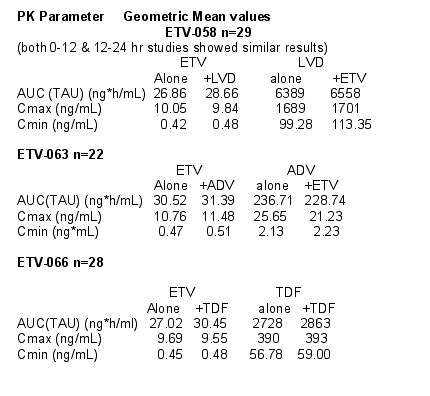 |
 |
 |
| |
Lack of Pharmacokinetic Interaction When Entecavir is Co-Administerd with Lamivudine,, Adefovir, or Tenofovir and Entecavir Dosing with Renal Impairment
|
| |
| |
Reported by Jules Levin
This study & the study following on entecavir dosing in patients with renail impairment were presented at the 40th annual meeting of EASL (April 2005, Paris).
M. Bifano, J.H. Yan, J. Xie, S. Rahim, E. Elefant, D. Zhang, D. Grasela, F. LaCreta
Bristol-Myers Squibb Pharmaceutical Research Institute, Princeton, NJ, USA
Background
Entecavir (ETV) is a potent and selective anti-hepatitis B agent, and approved in the USA for the treatment of chronic hepatitis B.
In the future, entecavir may be used in combination with lamivudine, adefovir, or tenofovir for the treatment of chronic hepatitis B or in those patients co-infected with HBV & HIV. Entecavir, lamivudine (3TC), adefovir, and tenofovir are all eliminated predominantly unchanged in urine by glomerular filtration and active tubular secretion, therefore, competition for elimination between these drugs may occur.
The pharmacokinetic (PK) effects of co-administering ETV and lamivudine (LVD) (ETV-058); ETV and adefovir (ADV) (ETV-063); and ETV and tenofovir (TDF) (ETV-066) were evaluated in three separate Phase I studies.
The PRIMARY OBJECTIVES of this study was to evaluate the potential for pharmacokinetic interaction of co-administering entecavir with each of three other antihepatitis B agents in three separate Phase I trials.
The secondary objectives were to evaluate the safety of entecavir, lamivudine, adefovir & tenofovir when administered alone and to evaluate the safety of co-administration of entecavir with 3TC, adefovir or tenofovir.
All studies were open-label, multiple dose, sequential design trials in healthy subjects that evaluated the steady-state PK of each drug alone and in combination. Blood and urine samples were collected for PK analyses pre- and post-dosing. ETV, ADV, TDF, and LVD concentrations were determined using validated LC/MS/MS or HPLC/UV methods. PK analyses were conducted using non-compartmental methods.
RESULTS
PK parameters of ETV, LVD, ADV and TDF given alone and in combination are shown in the associated table. There was no effect of co-administration of LVD, ADV, or TDF on ETV pharmacokinetics.
Similarly, ETV had no effect on the pharmacokinetics of LVD, ADV, or TDF.
The concomitant administration of lamivudine, adefovir, or tenofovir with entecavir did not appear to impact the safety profile of entecavir in a clinically significant manner.
For all combinations tested, the adjusted geometric means for AUC(TAU), Cmax, and Cmin of each drug when co-administered were similar to those values for the drug alone: in every case, the corresponding 90%CIs satisfied the pre-specified criteria (0.80-1.25) for lack of effect.

Author Conclusion: ETV may be co-administered with LVD, ADV, or TDF without dose modification of either ETV or the co-administered drug.
EFFECTS OF RENAL IMPAIRMENT ON SINGLE-DOSE PHARMACOKINETICS OF ENTECAVIR
J.H. Yan, M. Bifano, J. Xie, J. Freund, S. Rahim, D. Zhang, D. Grasela, F. LaCreta
Bristol-Myers Squibb Pharmaceutical Research Institute, Princeton, NJ, USA
Background: Entecavir (ETV) is a potent anti-hepatitis B agent which is primarily eliminated via renal excretory pathways. This Phase I study assessed the effect of renal impairment on the pharmacokinetics (PK) of ETV after a single oral dose.
Methods: ETV-011 was an open-label, parallel group study in which 34 subjects were assigned to 1 of 6 groups based on renal function: A = normal (CLcr > 80 mL/min); B = mild impairment (50 < CLcr < 80 mL/min); C = moderate impairment (CLcr 30-50 mL/min); D = severe impairment (CLcr < 30 mL/min) not requiring dialysis; E = severe impairment, managed with hemodialysis; and F = severe impairment, managed with continuous ambulatory peritoneal dialysis (CAPD).
Subjects received a single oral dose of ETV 1.0 mg. Group E received a single oral dose of ETV 1.0 mg on 2 separate occasions: prior to hemodialysis (E1) and, after a washout period, following hemodialysis (E2).
PK samples were collected pre-dose and up to 336 hours (blood) or 168 hours (urine) post-dose. ETV concentrations were determined using validated LC/MS/MS methods. PK analyses for ETV were conducted using non-compartmental methods.
Results
Relative to healthy subjects with normal renal function, subjects with mild to severe renal impairment, including those requiring dialysis, have ETV Cmax increased between 29% and 106%, and ETV AUC(0-T) increased between 84% and 738%. Clearance (ml/min) was reduced from 390 in Group A to 197 in group B, 135 in Group C, & 40.27 in Group D.
Author Conclusion
Dosage adjustment of ETV is warranted when administered to patients with renal impairment.
|
|
| |
| |
| |
|
 |
 |
|
|